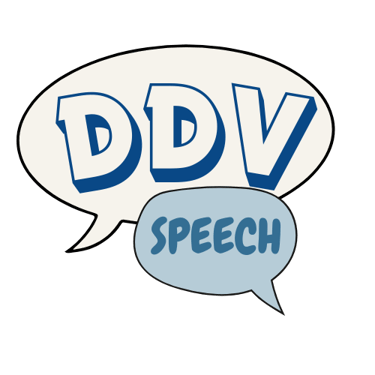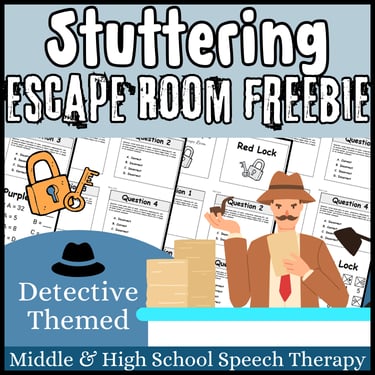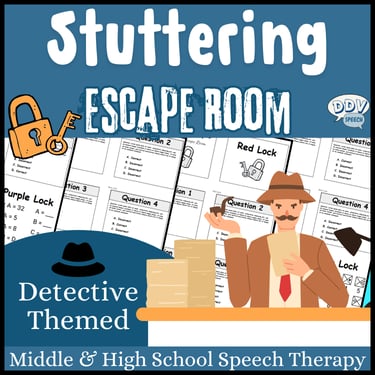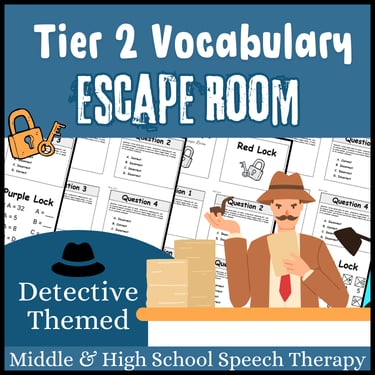Engaging Speech Therapy Games: Escape Rooms
Discover how escape rooms serve as effective speech therapy games for older students. Learn the benefits of gamification in therapy and grab a free stuttering escape room activity to implement in your sessions!
MIDDLE SCHOOL SPEECH THERAPY
5/1/20255 min read


Escape Rooms Make the Perfect Speech Therapy Game for Older Students
Speech-language pathologists (SLPs) who work with older students have to keep things fresh. Students will let you know if activities are boring, babyish, or redundant.
Since building rapport and maintaining interest is essential with middle and high school speech therapy, escape rooms are a winner for game-based learning.
Using escape rooms to gamify speech-language targets works because they are fun and work across a range of ability levels. Best of all, you can use them across settings, in small or large groups, or in virtual telepractice sessions!
From my own experience, and speaking to other SLPs, I know that you may feel unprepared for working with older students who stutter. On the one hand, you want to use neurodiversity-affirming approaches that align with awareness and acceptance of stuttering. On the other hand, your training may have focused on fluency shaping strategies that your students have been practicing for years.
If this sounds familiar, keep reading and grab a Stuttering Escape Room FREEBIE you can download and use tomorrow!
Why Gamification Works in Learning and Speech Therapy
Gamification means adding game elements to non-game tasks. You can read more tips for incorporating game elements into learning activities here. This evidence-based, collaborative approach results in:
Improved participation
Longer attention span (time on task)
Interaction and collaboration with peers
Motivation to complete tasks
In speech therapy, these benefits are obvious given the smaller group and reduced structure of sessions. Game-based learning such as escape rooms give students authentic opportunities to solve problems and communicate. This is especially valuable for neurodiversity-affirming approaches as students learn about their own communication and learning styles.
For older students who stutter, escape rooms open discussion about stuttering in an affirming way—which makes them a perfect activity to try. Download your FREE sample stuttering escape room here.
If you like this activity check out my escape room set available on Teachers Pay Teachers that includes 7 different escape rooms and puzzles!
What is an Escape Room?
Escape Rooms are a fun outlet for kids and adults alike. Outside of schools, escape rooms are immersive games where people are "locked" into a room and have to solve puzzles and clues to escape. Of course, help is available if you get stuck. Here is a video link if you haven't experienced this family-fun adventure. I know my teens love to go to Escape Rooms with groups to celebrate birthdays and team-building outings! Click here for a quick video explaining Escape Rooms if this is new to you.
In classrooms, escape rooms are a great way to gamify learning. The escape room can be thematic for holidays or specific to target skills or learning standards. Classroom escape rooms can be a hands-on way for groups to integrate content, and I have used them with middle/ high schoolers as well as college students! Escape rooms tap into competition and collaboration, which keeps older students engaged.
Ideas for Building Stuttering Awareness Into Escape Rooms
Escape rooms support neurodiversity goals, including for stuttering. Rather than practicing fluency enhancing strategies, questions can address:
Affirmation: Acknowledging that all communication is valid.
Validation: Awareness that others may react to stuttering with different reactions that can cause trauma and stress.
Education: Learning strategies to use when facing speaking tasks and how to educate peers about stuttering.
Support: Explore the benefits of stuttering support groups and identify online or local resources.
Save time making escape room speech therapy games
I know how busy you all are as school-based SLPs. If you have 60-80 kids on your caseload, chances are only 2-3 students stutter.
So rather than spending hours putting together game-based learning on a specific topic, I made them for you! Using a neurodiversity-affirming approach, this pack of 7 escape rooms has a google slides and printable option so you can choose the format.
Guide students to record their answers, solve the puzzle at the end, and get to code to “unlock” the code.
Adapting Escape Rooms for Neurodivergent Students
Escape rooms can be made accessible for students with concomitant language learning disabilities, Autism, ADHD, or other support needs. If you are new to a neurodiversity-affirming approach in speech therapy, check out my article about Updated Neurodiversity Norms. Here are a few modifications that can help students work through escape room questions and puzzles if they need extra scaffolds:
Visual cues for turn-taking or answering. Print out the answer locks even if using google slides format so each group can track their own responses.
Program AAC responses for participation.
Clear rules discussed ahead of time. Who will write the responses? Who will answer questions? What happens if groups don’t agree on an answer?
Assign clear roles if working with groups of 3 or more.
If you need more strategies to gamify learning for different types of students, check out this article.
Want to Try It for Free?
Get your downloadable Stuttering Escape Room Freebie here!
Tried it and love it?
If you like the Stuttering Escape Room freebie, check out my Full Stuttering Escape Room here. It includes 7 puzzles that include neurodiversity-affirming questions about stuttering including myths vs. facts, famous people who stutter, and strategies to use. All in a speech therapy game format to use all year!
Need to target vocabulary?
If you need to target language and vocabulary goals, check out this Tier 2 Vocabulary Escape Room. It also includes 7 separate puzzles that include Tier 2 Vocabulary with multiple choice questions and a sample sentence for context clues. This activity is ideal for students with specific language impairment (SLI) or language-learning disability (LLD) in 7th, 8th, 9th, or 10th grades. This evergreen format can be used throughout the school year.
Concluding thoughts: Make Therapy Fun and Functional
Escape rooms don’t have to be complicated. With just Powerpoint or Google slides you can create a fun, effective activity that targets therapy goals.
Most importantly, game-based learning like escape rooms will motivate middle and high schoolers to participate, especially those who may be reluctant to engage in traditional therapy tasks or have been in therapy for years.
Whether you're targeting stuttering facts vs. myths, peer education, or famous people who stutter, escape rooms can be your go-to activity year after year!
Join my Pack
Join my pack and get started with free neurodiversity-affirming handouts for speech-language pathologists.
Contact Katie
Connect
© 2024. All rights reserved.






